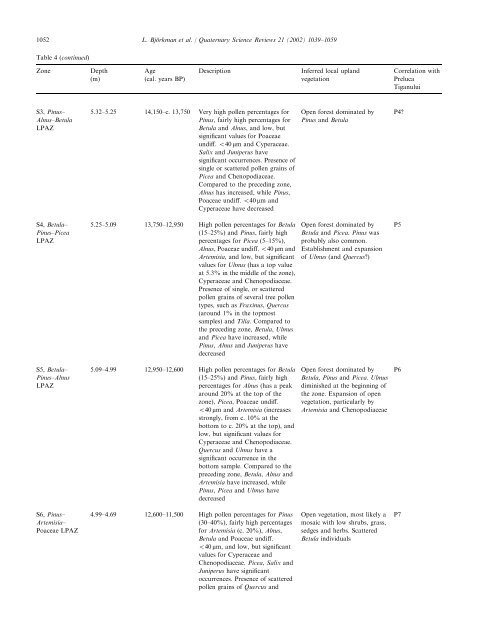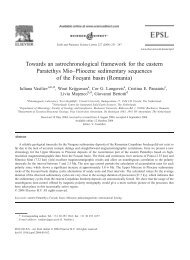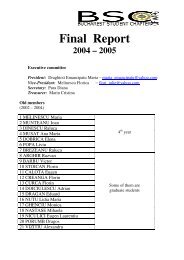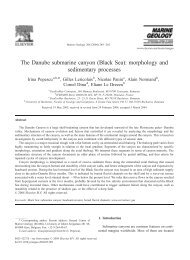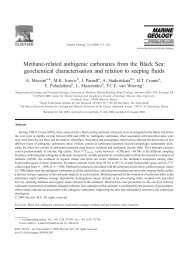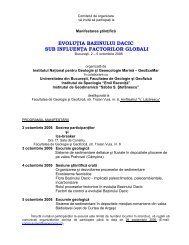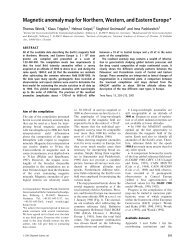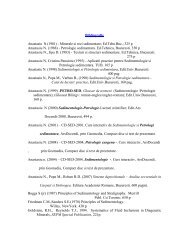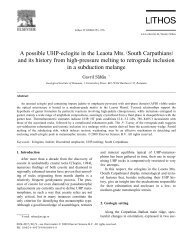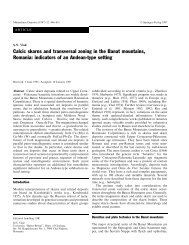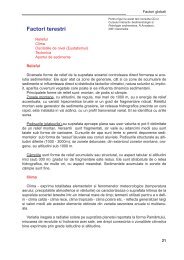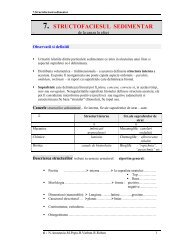Lateglacial and early Holocene vegetation ... - geo.edu.ro
Lateglacial and early Holocene vegetation ... - geo.edu.ro
Lateglacial and early Holocene vegetation ... - geo.edu.ro
You also want an ePaper? Increase the reach of your titles
YUMPU automatically turns print PDFs into web optimized ePapers that Google loves.
1052<br />
L. Bj .orkman et al. / Quaternary Science Reviews 21 (2002) 1039–1059<br />
Table 4 (continued)<br />
Zone<br />
Depth<br />
(m)<br />
Age<br />
(cal. years BP)<br />
Description<br />
Inferred local upl<st<strong>ro</strong>ng>and</st<strong>ro</strong>ng><br />
<st<strong>ro</strong>ng>vegetation</st<strong>ro</strong>ng><br />
Correlation with<br />
Preluca<br />
Tiganului<br />
S3, Pinus–<br />
Alnus–Betula<br />
LPAZ<br />
S4, Betula–<br />
Pinus–Picea<br />
LPAZ<br />
5.32–5.25 14,150–c. 13,750 Very high pollen percentages for<br />
Pinus, fairly high percentages for<br />
Betula <st<strong>ro</strong>ng>and</st<strong>ro</strong>ng> Alnus, <st<strong>ro</strong>ng>and</st<strong>ro</strong>ng> low, but<br />
significant values for Poaceae<br />
undiff. o40 mm<st<strong>ro</strong>ng>and</st<strong>ro</strong>ng> Cyperaceae.<br />
Salix <st<strong>ro</strong>ng>and</st<strong>ro</strong>ng> Juniperus have<br />
significant occurrences. Presence of<br />
single or scattered pollen grains of<br />
Picea <st<strong>ro</strong>ng>and</st<strong>ro</strong>ng> Chenopodiaceae.<br />
Compared to the preceding zone,<br />
Alnus has increased, while Pinus,<br />
Poaceae undiff. o40 mm<st<strong>ro</strong>ng>and</st<strong>ro</strong>ng><br />
Cyperaceae have decreased<br />
5.25–5.09 13,750–12,950 High pollen percentages for Betula<br />
(15–25%) <st<strong>ro</strong>ng>and</st<strong>ro</strong>ng> Pinus, fairly high<br />
percentages for Picea (5–15%),<br />
Alnus, Poaceae undiff. o40 mm<st<strong>ro</strong>ng>and</st<strong>ro</strong>ng><br />
Artemisia, <st<strong>ro</strong>ng>and</st<strong>ro</strong>ng> low, but significant<br />
values for Ulmus (has a top value<br />
at 5.3% in the middle of the zone),<br />
Cyperaceae <st<strong>ro</strong>ng>and</st<strong>ro</strong>ng> Chenopodiaceae.<br />
Presence of single, or scattered<br />
pollen grains of several tree pollen<br />
types, such as Fraxinus, Quercus<br />
(a<strong>ro</strong>und 1% in the topmost<br />
samples) <st<strong>ro</strong>ng>and</st<strong>ro</strong>ng> Tilia. Compared to<br />
the preceding zone, Betula, Ulmus<br />
<st<strong>ro</strong>ng>and</st<strong>ro</strong>ng> Picea have increased, while<br />
Pinus, Alnus <st<strong>ro</strong>ng>and</st<strong>ro</strong>ng> Juniperus have<br />
decreased<br />
Open forest dominated by<br />
Pinus <st<strong>ro</strong>ng>and</st<strong>ro</strong>ng> Betula<br />
Open forest dominated by<br />
Betula <st<strong>ro</strong>ng>and</st<strong>ro</strong>ng> Picea. Pinus was<br />
p<strong>ro</strong>bably also common.<br />
Establishment <st<strong>ro</strong>ng>and</st<strong>ro</strong>ng> expansion<br />
of Ulmus (<st<strong>ro</strong>ng>and</st<strong>ro</strong>ng> Quercus?)<br />
P4?<br />
P5<br />
S5, Betula–<br />
Pinus–Alnus<br />
LPAZ<br />
5.09–4.99 12,950–12,600 High pollen percentages for Betula<br />
(15–25%) <st<strong>ro</strong>ng>and</st<strong>ro</strong>ng> Pinus, fairly high<br />
percentages for Alnus (has a peak<br />
a<strong>ro</strong>und 20% at the top of the<br />
zone), Picea, Poaceae undiff.<br />
o40 mm<st<strong>ro</strong>ng>and</st<strong>ro</strong>ng> Artemisia (increases<br />
st<strong>ro</strong>ngly, f<strong>ro</strong>mc. 10% at the<br />
bottomto c. 20% at the top), <st<strong>ro</strong>ng>and</st<strong>ro</strong>ng><br />
low, but significant values for<br />
Cyperaceae <st<strong>ro</strong>ng>and</st<strong>ro</strong>ng> Chenopodiaceae.<br />
Quercus <st<strong>ro</strong>ng>and</st<strong>ro</strong>ng> Ulmus have a<br />
significant occurrence in the<br />
bottom sample. Compared to the<br />
preceding zone, Betula, Alnus <st<strong>ro</strong>ng>and</st<strong>ro</strong>ng><br />
Artemisia have increased, while<br />
Pinus, Picea <st<strong>ro</strong>ng>and</st<strong>ro</strong>ng> Ulmus have<br />
decreased<br />
Open forest dominated by<br />
Betula, Pinus <st<strong>ro</strong>ng>and</st<strong>ro</strong>ng> Picea. Ulmus<br />
diminished at the beginning of<br />
the zone. Expansion of open<br />
<st<strong>ro</strong>ng>vegetation</st<strong>ro</strong>ng>, particularly by<br />
Artemisia <st<strong>ro</strong>ng>and</st<strong>ro</strong>ng> Chenopodiaceae<br />
P6<br />
S6, Pinus–<br />
Artemisia–<br />
Poaceae LPAZ<br />
4.99–4.69 12,600–11,500 High pollen percentages for Pinus<br />
(30–40%), fairly high percentages<br />
for Artemisia (c. 20%), Alnus,<br />
Betula <st<strong>ro</strong>ng>and</st<strong>ro</strong>ng> Poaceae undiff.<br />
o40 mm, <st<strong>ro</strong>ng>and</st<strong>ro</strong>ng> low, but significant<br />
values for Cyperaceae <st<strong>ro</strong>ng>and</st<strong>ro</strong>ng><br />
Chenopodiaceae. Picea, Salix <st<strong>ro</strong>ng>and</st<strong>ro</strong>ng><br />
Juniperus have significant<br />
occurrences. Presence of scattered<br />
pollen grains of Quercus <st<strong>ro</strong>ng>and</st<strong>ro</strong>ng><br />
Open <st<strong>ro</strong>ng>vegetation</st<strong>ro</strong>ng>, most likely a<br />
mosaic with low shrubs, grass,<br />
sedges <st<strong>ro</strong>ng>and</st<strong>ro</strong>ng> herbs. Scattered<br />
Betula individuals<br />
P7


